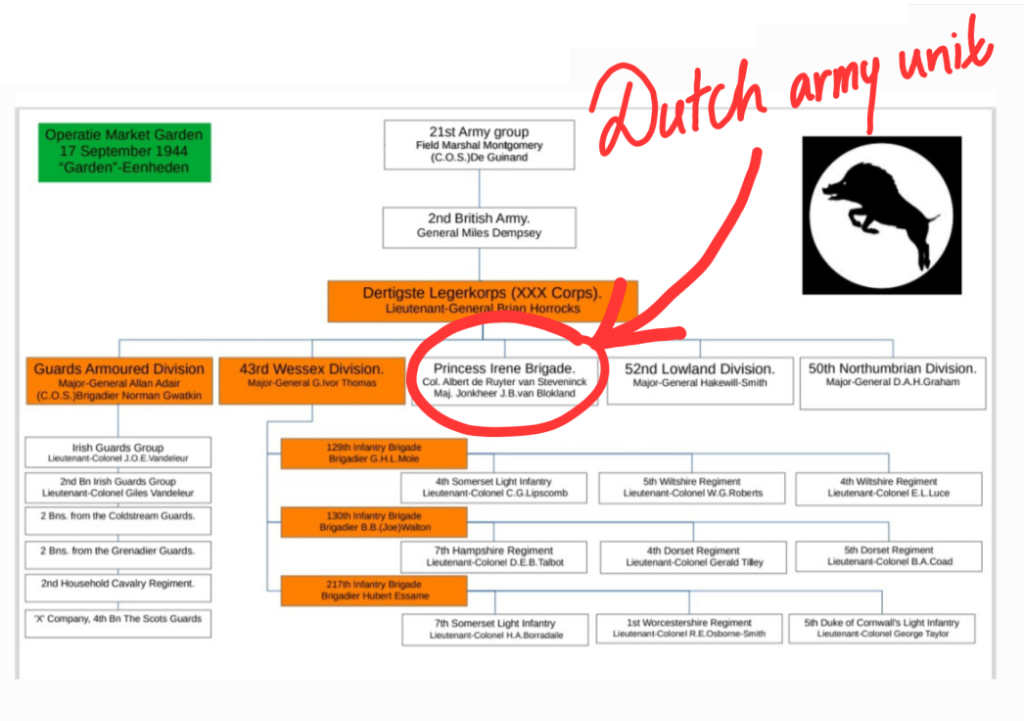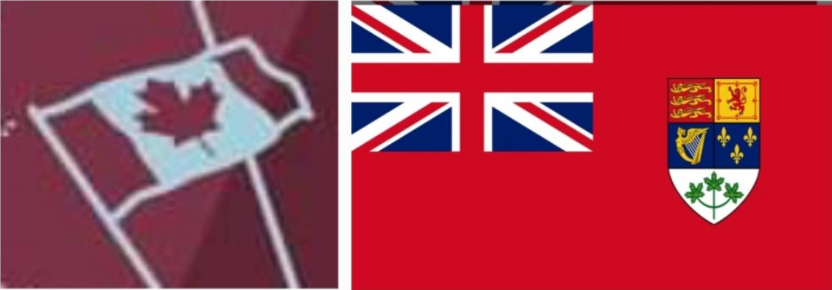Operation Market Garden
- One of the largest airborne operations of World War II
- Fought in the German-occupied Netherlands from 17 to 25 September 1944.
- To free us from Nazi Germany.
- To outflank the German defenses along the Rhine (the Westwall) and to ensure a swift advance towards the industrial heart of Nazi-Germany. And to end the Second World War before Christmas 1944.
- Consisted of a large-scale airborne operation (codenamed “Market”) and a ground offensive from Belgium (codenamed “Garden”).
On the front of the design you see a part of England, Belgium and the Netherlands, with emphasis on places such as Eindhoven, Nijmegen and Arnhem.

At the bottom you see a row (from left to right) of divisions:
- The British 1st Airborne Division (pegasus logo).
- The 1st (Polish) Independent Parachute Brigade (falcon)
- The All American (AA) 82nd Airborne Division.
- The 101st Airborne Division (Air Assault); “Screaming Eagles”.
- The 30th corps, also known as the XXX-corps (rampant boar).
Operation Market Garden consisted of two sub-operations:
- Market; airborne operation
- Garden; ground offensive from Belgium.

Operation Market:
- A drop of approximately 35,000 airborne troops.
- Landed by glider and by parachute.
- An airborne operation employing three divisions:
- The American 101st Airborne Division (“Screaming Eagles”) and the 82nd Airborne Division (All American) were dropped in the area around Eindhoven and Nijmegen.
- While the British 1st Airborne Division (Pegasus) and the Polish 1st Independent Airborne Brigade (Falcon) were deployed near Arnhem.
- Their task was to capture the key bridges and to hold the terrain until they could be supported by the ground troops (Garden).





Operation Garden:
- The advance of the ground troops from the Belgian border to the Rhine bridge in Arnhem.
- Carried out by the British 30th Corps of the British second army, also known as the XXX Corps (leaping boar).

Several Canadian officers served under the CANLOAN program (or the Canada Loan program). This was a program set up in 1944 to loan officers from the Canadian Army to serve in British Army units such as:
- The British 1st Airborne Division in Arnhem.
- 1st Battalion The Border Regiment
- 1st Parachute Battalion Headquarters
- Thee 2nd Battalion South Staffords
- 7th Battalion, The King’s Own Scottish Borderers.
- 11th Parachute Battalion.
- The 30th Corps (XXX Corps).
- 43rd Wessex Division.
- 204th Field Company.
- 4th Dorset Regiment.
- Guards Armoured Division.
- No. 4 Company 1st Grenadier Guards
- 43rd Wessex Division.
So the Canadians were (divided) into these 2 divisions:

In addition, among other things, the Canadians were also deployed in Arnhem-Oosterbeek, for the evacuation of the British 1st Airborne Division (Pegasus).
These were the:
- 20th Field Company, Royal Canadian Engineers
- 23rd Field Company, Royal Canadian Engineers.
Since the Canadian effort has also been severely underexposed, I will pay more attention to this in the new design next year (2025).
On the back of the current design I have chosen to use the current flags of all the allied countries involved.

Most of the Canadian veterans do not wish to see the flag of that time. The old flag is still from the old British colonial times under the British empire. And from the bad times full of ethnocentrism in Canada. While the new flag refers to the cultural independence and the modern synergistic society of Canada.
Moreover, most monuments and commemorations also use the current flags as a tribute to and as respect for the countries involved. Also in the current time and composition.
On the back of the design, from left to right, you can see the current flags of England, America, Canada, the Netherlands and Poland above the poppy, which symbolises war commemoration. A pioneer species, which means that it will be the first to grow on freshly turned or polluted, barren, poor soil where other plants will have a harder time to establish. Due to the massive destruction on the battlefields, there was a massive growth of poppies afterwards. Something that has stuck with many over the years. Hence the meaning of this symbol.
Furthermore, the following are depicted on the back, one below the other:
Halifax bomber
This was used, among other things, as a tow plane for the gliders.
Dakota skytrain 2 of them.
This was used, among other things, as a tow plane for the gliders.
WACO ‘Cargo Glider’
Glider from the United States. They carried not only troops, but also jeeps, trailers with supplies and howitzers. Material was loaded by hinging the nose upwards. Capacity: 13 troopers. Or a jeep and 4 troopers.
Horsa Glider
The British Airspeed Horsa.
Behind the hangar compartment was the cargo loading door on the port side; the revolving door could also be used as a loading ramp. In addition, the fuselage connection at the rear of the main body could be broken on landing to facilitate the rapid unloading of troops and equipment, for which ramps were provided. Capacity: 30 troopers. Or 2 ¼ton trucks. Or 1 M3A1 Howitzer + ¼ton truck with ammunition and crew / (20-25 troops were the “standard” cargo).
Paratroopers:
The paratroopers and airborne infantry landed near Eindhoven, Nijmegen and Arnhem to capture the most important bridges over the Maas, Waal and Rhine. The latter proved to be a bridge too far.
Well-known vehicles:
- Sherman (American)
- Bedford (British)
- Daimler dingo (British)
- Bran gun carrier (generally British)
- Jeep (used by all allied forces)
The text;
“Lest we forget
Market Garden
1944 – 2024″
Is drawn up on the basis of a handwriting from that time.
My idea behind this was to convey a personal message from them, as it were. To see to and to respond to the wishes of our heroes, as well as their actions in the interest of our
They wish never to be forgotten.
So why not design something to fulfill their wishes.
If that is the least I could do?
Lest we ever forget.
Thank you for supporting our heroes by taking an interest in this matter.